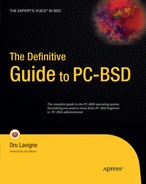0%
26Chapters
0-1Hours read
0kTotal Words
Book Description
This book is the ultimate reference for both beginners and power users to PC-BSD—the free, easy-to-use operating system based on FreeBSD. Existing power users will learn how to look under the hood and contribute to the global PC-BSD community. PC-BSD is turning into a hassle-free alternative to Linux on the desktop.
Table of Contents
- Copyright
- Foreword
- About the Author
- About the Technical Reviewers
- Acknowledgments
- Introduction
- 1. Getting Started with PC-BSD
- 2. USING THE PC-BSD DESKTOP
- 3. Customizing the Desktop
- 4. Getting Around
- 5. Performing Common Tasks
- 6. User System Settings
- 7. Administrative System Settings
- 3. SOFTWARE
- 8. Push Button Installer System
- 9. FreeBSD Packages
- 10. FreeBSD Ports
- 10.1. Package or Port?
- 10.2. What is Compiling a Port?
- 10.3. Installing the Ports Collection
- 10.4. What Does a Port Contain?
- 10.5. make Targets
- 10.6. Troubleshooting Errors
- 10.7. Keeping the Ports Tree Updated
- 10.8. Updating Ports
- 10.9. Creating Your Own Notification Script
- 10.10. Using portupgrade
- 10.11. Uninstalling a Port
- 10.12. Summary
- 4. COMMUNITY
- 11. Getting Help
- 12. Getting Involved
- 5. GOING BEYOND THE BASICS
- 13. Advanced Tasks
- 14. Becoming a Developer
- A. Reference Tables
